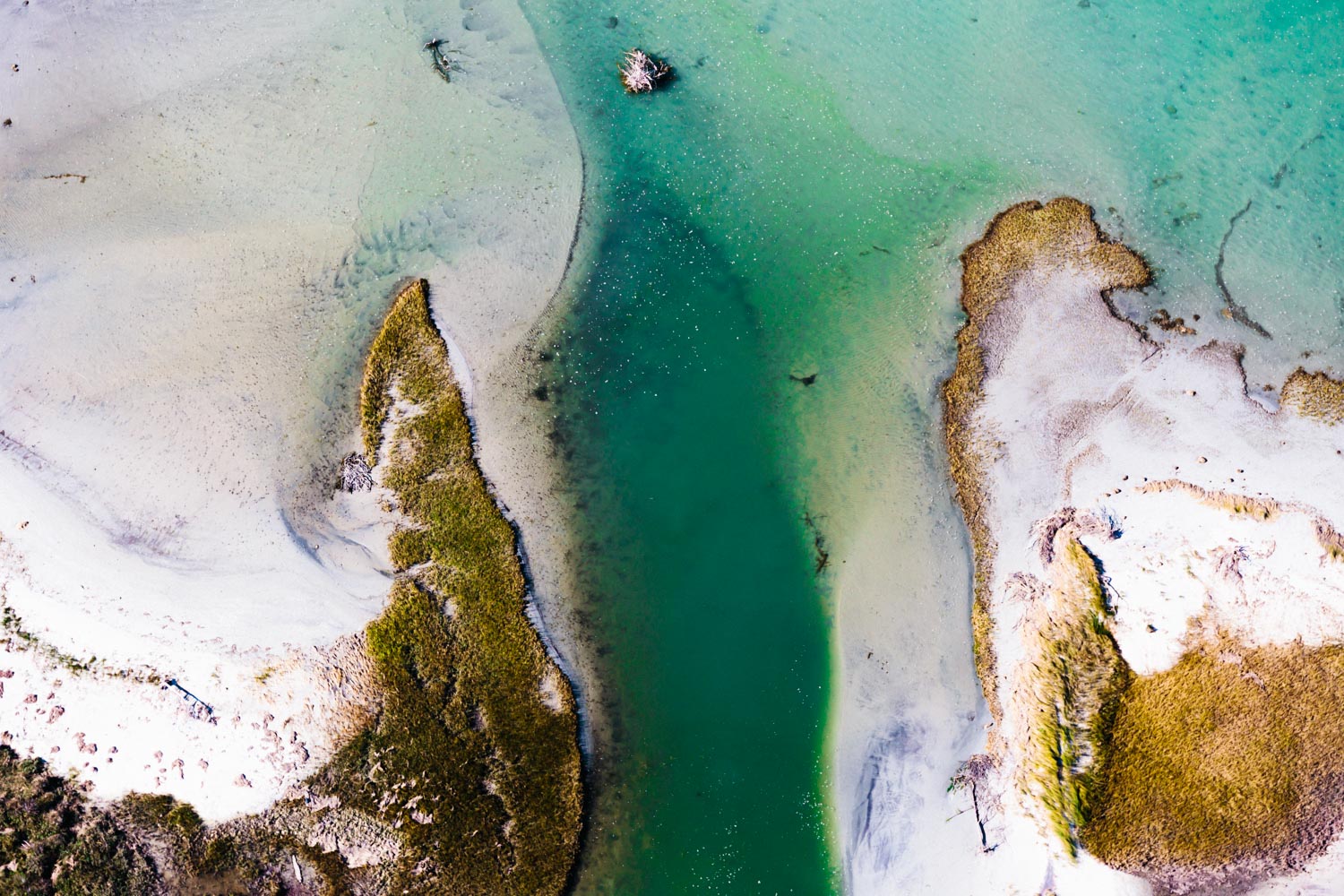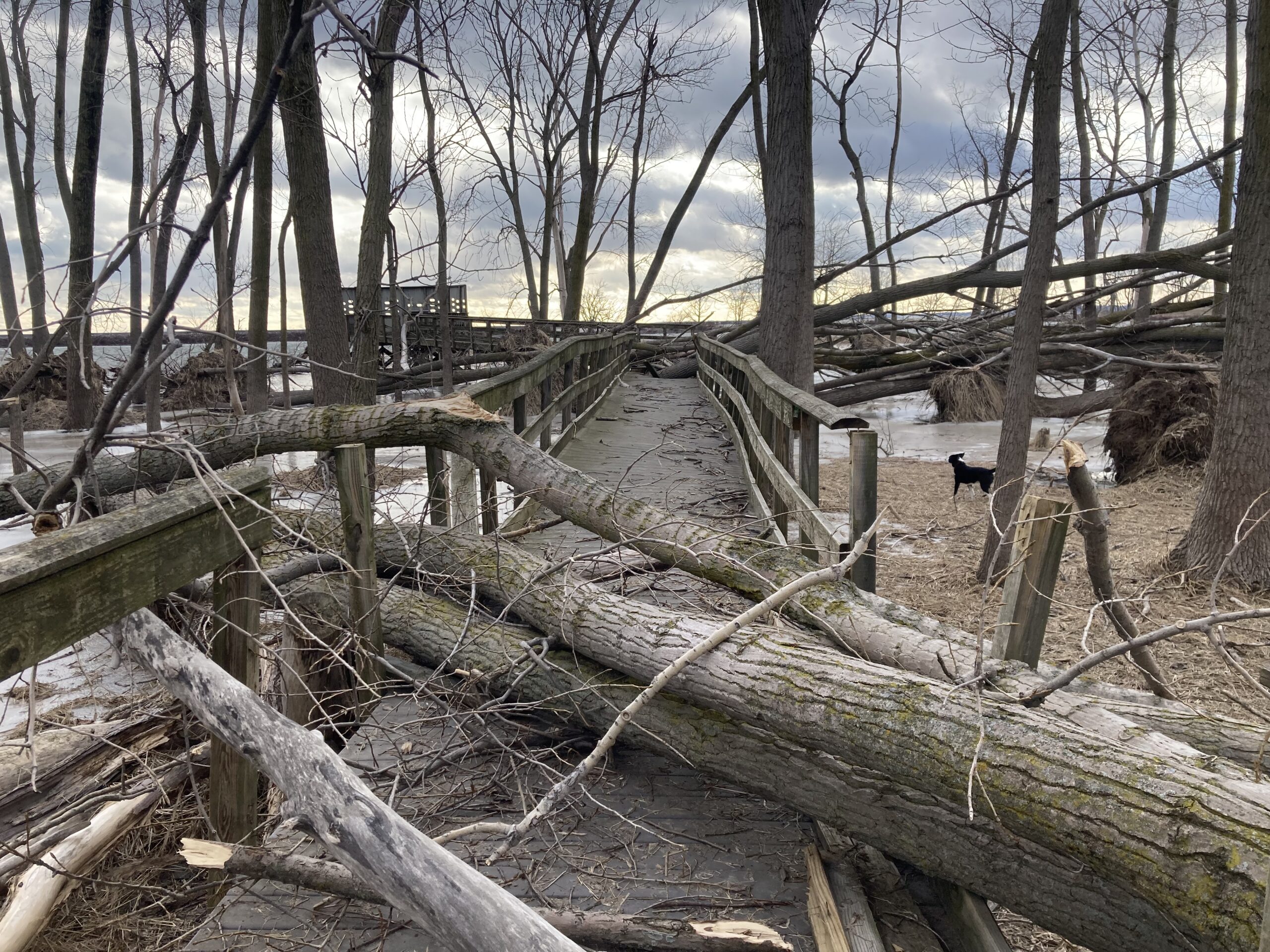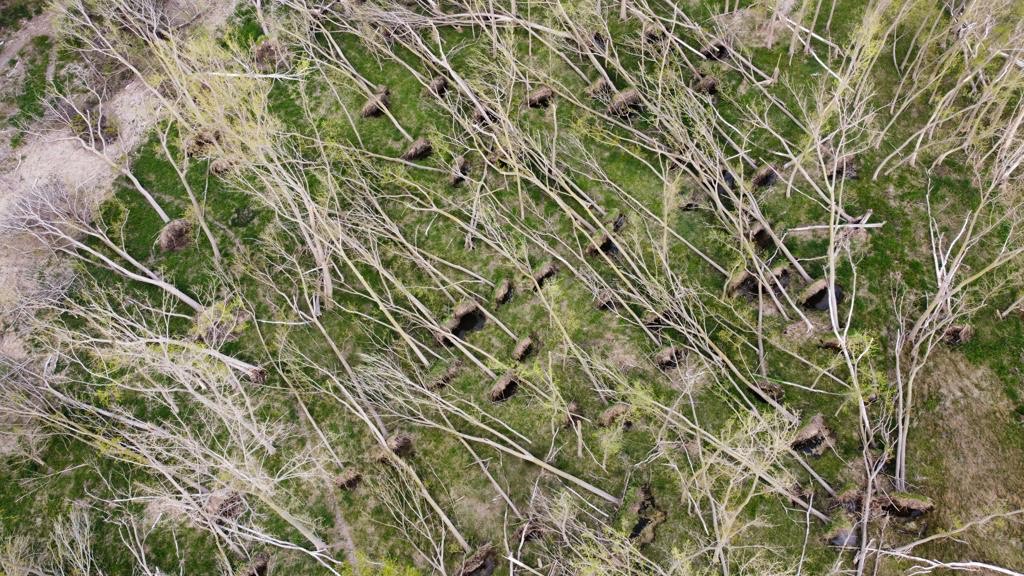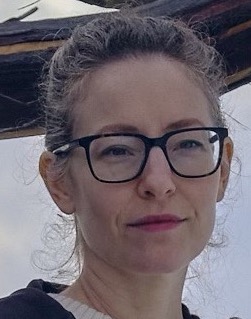
34°53’06.8″N ,76°16’33.3″W. Used with permission.
Written as a dialogue, this post brings into conversation our respective research on two U.S. coasts at risk from climate change: the Outer Banks on North Carolina’s Atlantic seaboard and the Buffalo Waterfront on New York’s Lake Erie. This coastal comparison foregrounds the growing ubiquity of the term “resilience.” While it has been used by ecologists since the early 1970s, the term has, over the past decade, entered the domain of governmental and civic institutions. As a result, we are tracking the cultural politics of a polysemous term-in-the-making as it is used by experts and non-experts in our field sites to refer to land, communities, institutions, and subjectivities. We find that its overarching power lies in how it naturalizes the morality of overcoming adversity and vulnerability. This quality leads social actors, even with antagonistic politics, to claim resilience as a guiding principle. Because of the institutions in which it circulates, the idea has acquired the material power to shape the future of coastlines and coastal communities. Our conversation highlights the need for scholars across disciplines to examine various uses of resilience, and resist accepting the term prima facie.
In what follows, we generally use the term “resilience” ethnographically (as used by people in our field sites), though we limit scare quotes for the sake of readability. Phil’s contributions also reflect the norm in his discipline of geography, where scholars employ resilience as a conceptual analytical term.
***
Hillary: The Outer Banks of North Carolina is a good place in which to think about ecological change. In fact, you can’t escape it. The land changes quickly and on multiple scales. People can see it happening, sometimes overnight. A low-lying strip of barrier islands in the Atlantic, the Banks is composed of compacted peat and mud, sand, gravel, and shell beds. Storms, waves, and wind regularly open inlets and rework older layers of sediment, which causes the islands to slowly migrate inland. Geologists call it dynamic and “one of the highest-energy coastal systems in the world.” Locals used to call it inhospitable. Large-scale construction began in the 1920s and intensified with each passing decade. Engineering projects shaped the land for mass tourism by stabilizing sand dunes, building roads, bridges, and houses, digging septic systems, and dredging channels. This development, along with climate-driven sea-level rise, is exacerbating erosion and storm damage, particularly from flooding. Today, the Outer Banks supports about 40,000 residents and millions of visitors. Its tourist industry and ocean-front real estate market is worth billions. Some towns are full of shops and restaurants, cut through with a multilane highway. Others retain the feel of fishing villages. To protect the human-built infrastructure, people must actively manage the Banks. They reconstruct dunes and stabilize inlets, dredge nearshore sites, and “nourish” beaches by pumping sand. When discussing such projects, coastal scientists and engineers often call them “resilient.” That’s where I first heard the term used.
Phil: Resilience is also a framing concept for different groups working to redevelop Buffalo’s post-industrial waterfront, but the geographical and historical context gives the term a slightly different resonance than in North Carolina. Buffalo was founded when settlers transformed a dynamic deltaic wetland into one of the nineteenth century’s great commercial harbors. As the Western terminus of the Erie Canal, Buffalo was a key inland port linking Midwest timber, grain, and ore to the eastern seaboard. It’s been 40 years since deindustrialization, and the waterfront landscapes are vast brownfields that the city has tried to develop over and again in the hopes of economic revitalization and “resurgence”—another local buzzword and, uncoincidentally, the name of one of Buffalo’s new waterfront breweries.

But climate change is recontextualizing these lands. The problem is not monotonic sea level rise, like in the Outer Banks. What’s happening in the Great Lakes is record lake level fluctuations and increased size and impact of seiche storm waves. These create risk for the city’s infrastructure. Environmental groups came together to develop a plan that prioritized, in their words, coastal resilience. The plan looked to redevelop some of the wetlands destroyed two centuries ago. Counter to this plan, the development corporation that manages the city’s outer harbor is trying to build a tourist destination and high-end housing in the same location. It also claims it is creating coastal resilience. It’s a struggle over land use. The place where wetlands would help to protect the city’s infrastructure and restore Lake Erie habitat doubles as valuable waterfront real estate. The developers don’t spell out what they mean by it, but when they talk about resilience, it tends to be tokenistic in terms of ecology—an old slip converted to a model wetland, for example. I think it’s just a rhetorical strategy: this ecological insinuation creates a slippage that helps to justify real estate speculation as a form of “economic resilience”: that is, the regional economy’s ability to withstand fluctuations in the global market. The US Army Corps of Engineers also seems to have its own definition of resilience, as it kicks off a major Great Lakes Resiliency Study in 2023.
Hillary: I’ve looked quite closely at the Army Corps in the Outer Banks since it plays a central role there. The civil Corps constructs and manages infrastructure—such as channels, dams, or jetties—that shape the land and water. In 2016, the Corps circulated a definition of resilience internally to urge its employees to think differently about their systems. Traditionally, Corps engineers used to think of their infrastructural systems as static; they lamented any irregularity as a failure. By contrast, a “resilient” project acknowledges and even embraces unpredictability—it’s a different way to think about the future. And yet embracing unpredictability is still always in service of reasserting regularity, usually by “managing” the system. The best pithy definition I heard from a Corps scientist is that resilience means “identifying vulnerabilities ahead of time and finding strategies to mitigate them.”
Phil: That sounds very familiar. In speaking with regional climate scientists about resilience, they clarify that they are not trying to diminish unpredictability, but they are looking to calculate it. They insist, in essence, that weather and climate are unpredictable and that’s the reason we need resilient systems. Because we are always going to be surprised when changes come but we can be sure that they will come.
Your comment about managing unpredictability reminds me of the attempts by the International Joint Commission—which is the binational agency that oversees the Great Lakes—to build large-scale infrastructure to control lake levels. The IJC oversaw the building of the Compensating Works in the 1910s and the Moses-Saunders Dam in the 1950s, which compress lake level fluctuations on Lakes Superior and Ontario, respectively. Lake levels are constantly changing and are highly unpredictable from season to season. They are also integral to the ecological resilience of coastal ecosystems. But lake level stabilization is good for shipping, erosion control, and hydropower. In the 1980s the IJC considered building a facility on the Niagara River to control levels on Lake Erie too, but by that time, ecologists were able to demonstrate that suppressing lake level change would further harm fisheries and destroy habitat. I interviewed a leading Great Lakes wetlands ecologist, Douglas Wilcox, who was instrumental in getting the IJC to allow greater fluctuations on Lake Ontario after 2014. His research demonstrated that lake level change created the disturbance essential for maintaining resilient coastal ecosystems in the Lake Ontario basin. So here you have one key confusion: resilience is an essential aspect of ecosystem health but it has also come to name a risk management strategy for institutions like the IJC and Army Corps, and the line between these usages is hardly clear.
Hillary: I’m glad you just mentioned resilience in the context of ecosystems specifically since that is the original technical use of the term. I want to circle back to that point, but I think it’s worth underlining that in both of our coastal field sites we are seeing how the word resilience justifies variable management practices. It also indicates something like “ecologically and, therefore, ethically good.” That interests me as an anthropologist of North American Christianity who wants to know more about how people in dynamic ecological sites think about the future. What are the moral modes of governance that shape what is thinkable on the coast? In my experience, resilience is a prescriptive term for ecological malaise that exerts a strong moral claim. This unannounced claim is characteristic of how religious and secular forces interact in the modern world. Its power comes at least partly from how resilience evades capture; it is used everywhere and evokes a moral good, yet it is not highly debated in the public sphere–certainly compared to a deeply divisive term like “climate change.”
Perhaps that is why few scholars of religion have critically engaged the term resilience. What I mean is that, although more studies of religion are reproducing resilience as an empirical category, there is little debate about what it means and how it is being used. That’s why I wanted to have this conversation with you, Phil, because resilience is highly contested in your academic fields. As a geographer who has studied the origins and applications of the concept in ecology, where does it come from? Who is debating its use and how?
Phil: Yes, I am a human geographer trained in the field of political ecology, which connects environmental issues with questions of political economy and knowledge production. A Canadian ecologist, Buzz Holling, developed the term resilience in the early 1970s while studying wildlife population dynamics. He found that, against the predominant idea of homeostatic equilibrium, ecosystems adapt through disturbance, not in spite of it. He termed “resilient” those ecosystems that could restore structure and function after perturbations. So, the term comes from ecology, but it quickly came to be understood as a general feature of all systems—be they ecological, social, psychological, or cultural. Carl Folke and Fikret Berkes, colleagues and occasional co-authors with Holling, pioneered work on social-ecological system (SES) resilience. It became an important concept in social science to understand how communities dealt with various kinds of hazards and disasters: from earthquakes and hurricanes to war, market instability, and poverty. But managing human systems like ecological ones has some insidious outcomes.
Hillary: It’s interesting to know the origins in Holling’s work. In the Outer Banks, I’ve seen a similar trajectory in my surveys of local newspapers. Based on what I’ve found, it was Duke University geologist Orrin Pilkey who, in 1972, first used “resilience” in the local news. He was almost certainly in conversation with ecologists like Holling because he, too, was talking about ecosystem dynamics. More specifically, he called the “natural features” of barrier islands resilient because they regenerate after storms and other disturbances. His goal was to make a political claim: he blamed humans—in particular, coastal property developers—for inhibiting natural regeneration. So, for Pilkey, human infrastructure was disrupting naturally resilient processes. His critique was fundamentally a moral one, as was the response from many Outer Banks property owners who claimed that economic resilience—though they did not use the term back then—was essential for human flourishing. Pilkey stirred up a lot of ire in the Outer Banks, but you were referring to social-ecological system resilience as insidious more generally. How so?

Phil: Well, the idea of community resilience got picked up in international economic development in the 1990s, in large part because it resonated with neoliberal thinking. Resilience measured a community’s ability to persevere in the face of poverty and natural hazards—without state-funded infrastructure. The World Bank even created a Resilience Rating System, which is not designed to help communities become more resilient but to assess levels of community resilience in order to identify better investment outcomes. Communities that lack resilience are bad investments. This system exacerbates vulnerability since much needed funds are directed away from those communities most immiserated by violence and disinvestment. Since resilience is ultimately about adaptation and survivability, these vulnerable communities get written off as unfit for survival, or at least for investment, which can very well be the difference between life and death. This situation has compelled non-governmental agencies to strategize how to increase community resilience, but, in the hands of big NGOs, this has turned into a technical problem of human, or population management.
Hillary: Terrifying. So resilience is justifying all sorts of radically different political outcomes. That question about human management—and its moral stakes—is also important in my field site but in a different way. As I mentioned, I heard it for the first time among coastal scientists and engineers, but it seemed unremarkable because they used it so frequently. But then I began to notice it in other locations: in the local newspaper, among government officials, and—unexpectedly—at a Christian non-profit. That’s when the polysemous nature of the term and its moral undertones really struck me.
Phil: What? You were hearing the term at church?
Hillary: Yes! Well, not in a church, but at Creation Justice Ministries (CJM), a non-profit that works extensively in coastal North Carolina and recently published the Faithful Resilience Guide. It also hosts events aimed at audiences from mainline or progressive evangelical churches that draw together speakers from different fields. One example is a panel at a CJM workshop on resilience in July 2022 that featured an environmental scientist based in North Carolina and an African American pastor from a United Church of Christ congregation in Atlanta. The scientist spoke first, and her view of resilience felt a bit different than the basic definition at the Corps and more in keeping with Orrin Pilkey’s view. She acknowledged significant overlap between resilience and adaptation, which she defined as “something new and you’re adapting to it…The climate is changing and therefore there is something to adapt to.” But when she talked about resilience itself, she implied that it is, foremost, a characteristic of ecosystems that are free from human tinkering. Here’s what she said: “[N]atural systems especially—wetlands, forests, mangroves, barrier islands—in their natural state they are very resilient ecosystems and so…[w]hen we restore those systems to the way they were before we interfered, they become more resilient—and they help us become more resilient.” This view seems similar to what I’ve heard among employees of environmental organizations who are building things like living shorelines and oyster barriers to mitigate erosion. From their perspective, a “resilient” system is an ideal: a project that humans might build but from which they can then withdraw or intervene very little. So there is some level of expert management, of course, but the resilient ecosystem becomes self-generating. No more humans needed! It becomes “like” natural, which is defined ipso facto as resilient.
Phil: You can really see here how ecological restoration slips into a moral imperative that plays on some very old tropes about “natural” Edenic landscapes being superior to anthropogenic—but really, to modern—ones. Of course, European theologians and natural historians alike thought Indigenous inhabitants were part of the land, so one mark of the Enlightenment was the ability to live separately from the land, or to dominate it. This points to one of the many ways in which scientific thinking about land borrowed—consciously or not— from theology, and it appears to have an afterlife in your scientist’s account.
A lot of my research on coastal resilience has uncovered something like the opposite: a conflation between coastal resilience and techno-managerialism. Most of what I hear tends to view coastal resilience as a design and planning principle tantamount to human micro-management over natural processes premised on socio-ecological systems modeling. But I want to hear more about how Christians are using the term. What did the pastor and the environmental scientist say about resilience? Sounds like the beginning of a joke.
Hillary: It does! I guess the punchline is that the pastor flipped her script. The scientist talked about ecosystems as resilient, which then help humans become resilient. By contrast, the pastor defined resilience as an attribute of people first—not ecosystems in their “natural” state. “We have to shift our focus from caring for climate to caring for community,” he began. “I’ve often said, if you help the people, you’ll heal the climate.” So people become resilient and then ecosystems flourish; the inverse of how the scientist put it. The pastor’s view comes from the pragmatic experiences of African American coastal communities disproportionately affected by poverty and lack of services. So, in his view, resilience means providing practical necessities like homes and electricity, as well as reducing future impacts by, for example, making sure those homes are constructed to withstand coastal storms. But addressing practical needs is the prelude to another type of resilience—“of mind and spirit.” He implied that spiritual resilience is, in fact, the most important bit. Other pastors who spoke that day stated it directly. They defined “spiritual resilience” as an internal quality that allows individuals to withstand significant challenges, leading to human thriving in relationship with God.
Phil: Oh, ok! Yes, we begin to see the proliferation of the concept. The application of resilience to the practical infrastructural necessities of everyday life is really the domain of what’s come to be called urban- or community resilience. One paper I remember reading listed thirty different definitions of urban resilience! Definitions ranged from speaking about resilience in infrastructure, economy, institutions, and social networks, but all pointed to the need to withstand social and economic disturbance, as well as natural hazards. It’s interesting that for the pastor, community resilience has its foundation in spiritual resilience, which perhaps derives from the idea of psychological resilience—yet another application—which has to do with overcoming personal struggle and childhood trauma.

There have been some interesting critiques of these uses of resilience too. Again, community and psychological resilience resonate with neoliberal ideas of the city and subject, respectively. Critics say, in essence, that vulnerability is not a natural phenomenon but a social condition. The desire for all systems to exhibit resilience in the face of vulnerability actually accords with the politics of (1) neoliberal urbanism, which looks to justify the removal of social support systems; and (2) neoliberal subjecthood, which asserts that success is a reflection of an individual’s ability to overcome hardship. These critiques make clear that resilience carries a naturalistic fallacy: because resilience is a natural phenomenon found in ecosystems, it justifies moralities structured like it, where overcoming struggle creates stability. In this respect, it’s kind of a twenty-first century version of social Darwinism. It has a quality of redemption—of having to overcome suffering and struggle to become whole. Does that play in the pastor’s sermonizing?
Hillary: I think you’re right about redemption—turns out you’d make a great religious studies scholar, Phil! Although the pastors at the CJM event did emphasize community-level change—one might say systems-level change—they ultimately prioritize resilience as an individual quality. But it isn’t the neoliberal individual of contemporary capitalism that concerns the critics you mentioned. It is the Christian individual who needs God for salvation and solace in times of difficulty. Obviously, we could get into a long conversation about the relationship between evangelical individualism and neoliberal capitalism, but I think for the moment it’s sufficient to point to how resilience has moved into new territory where it is being used to mean internal strength rooted in Christian salvation. That’s a radical departure from its original usage. And from how the Army Corps talks about resilience as strategies to mitigate damage to its infrastructure or how coastal scientists view resilience as an inherent quality in ecological systems where humans are (ideally) absent. It’s also a different kind of spiritual framework than that articulated by Indigenous communities and scholars. For example, indigenous environmental scholar, Kyle Whyte, redefined resilience as the Anishinaabe quality of “developing moral relationships, including responsibility, spirituality, and justice” (137). Not surprisingly, North Americans are mobilizing resilience to talk about a variety of spiritual qualities, which would profit from further comparison. So, returning to my own field site, I’m seeing the term resilience circulate quite widely in local communities but in ways that are inconsistent. Or, perhaps, “creative appropriations” is a better way to put it.
Phil: I think it’s a creative appropriation, but I do think it has to do with the naturalistic fallacy too—this idea that if it’s natural, it must be “good.” In my fieldwork, it’s been really useful to think about it in this way since it helps me understand why developers use “resilience” in the proper context but in a way that’s totally inaccurate. These developers are producing coastal vulnerability by building houses, hardscape, and infrastructure on the waterfront. But they’re calling it resilient. In calling development resilient, they suggest that they’re overcoming generations of economic hardship and creating investment opportunities in a way that is totally in line with natural processes.
Hillary: That’s an excellent point. So, bringing both our coastal sites into conversation, we’re seeing how resilience moves from a term that ecologists used to describe ecosystem function in the 1970s to one that all manner of specialists use to account for social and cultural processes. Resilience—that is, overcoming disturbance in order to adapt to hostile environments—gets analogized across systems, only it’s not understood as an analogy. Instead, it’s made to seem like a natural, and even morally correct, feature of those systems. That move has real consequences. In your case, developers use it to imply that engineers and planners should manage ecosystems to carry on business-as-usual. Perversely, what is actually resilient in that case are the capitalist processes that destroyed those ecosystems to begin with! That’s true of the Outer Banks as well. When it comes to Christians, although I’m hearing pastors use resilience to preface important critiques of social injustice, one implication is that communities that become resilient can stay on their land indefinitely—even coastal lands that will be uninhabitable. I was speaking to a pastor the other day who told me that a major challenge for future clergy will be to help people mourn land loss. I think she’s right. Christians have only recently adapted the term resilience so there needs to be more thinking about how it is used and to what end.
Phil: Exactly. How people interpret and employ this concept is going to have significant impacts on how our respective coastlines will be managed and imagined in the years to come.


